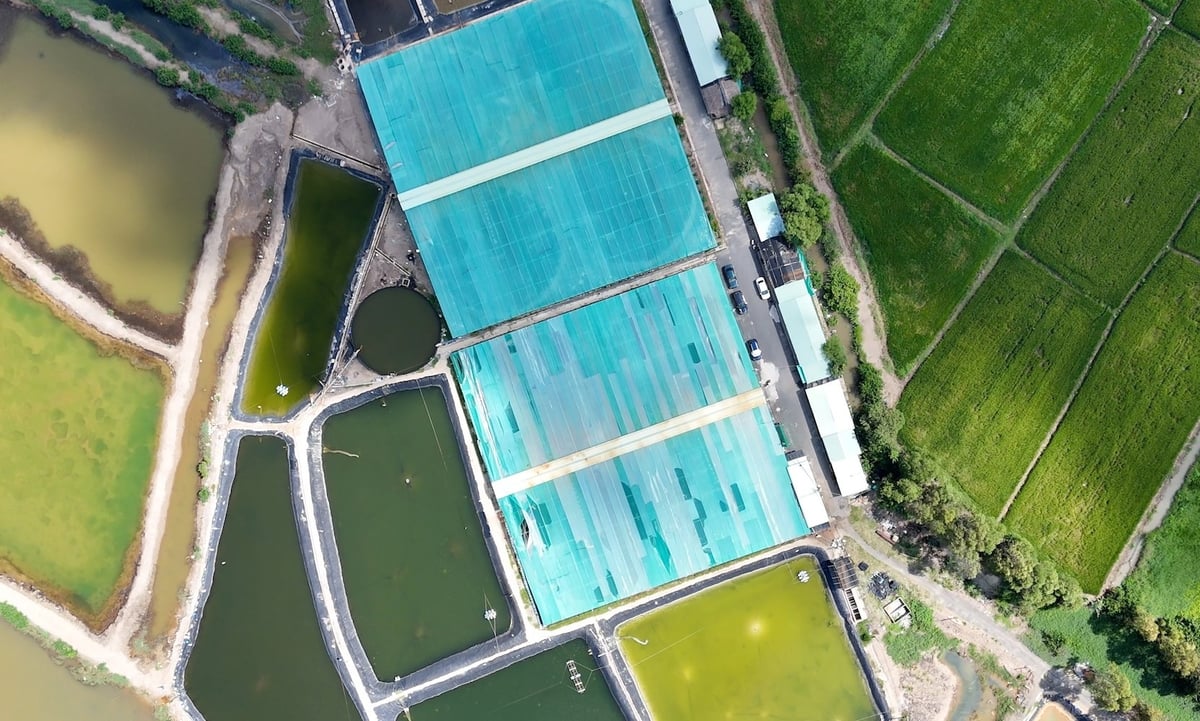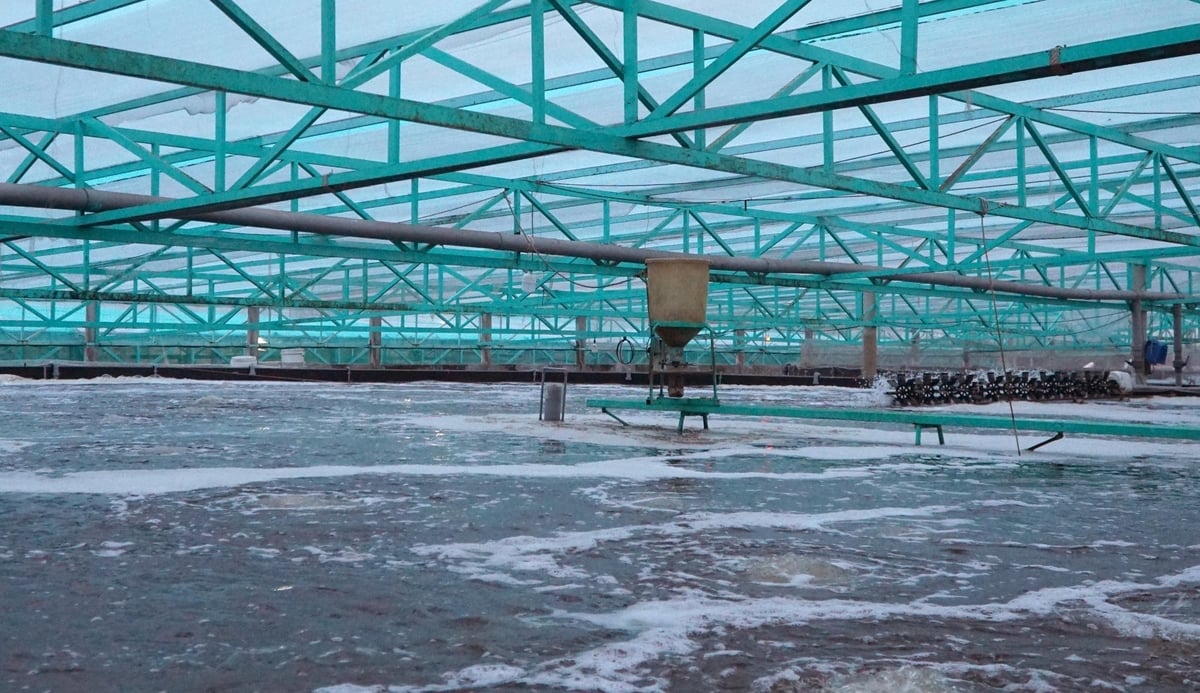October 19, 2025 | 20:03 GMT +7
October 19, 2025 | 20:03 GMT +7
Hotline: 0913.378.918
October 19, 2025 | 20:03 GMT +7
Hotline: 0913.378.918
Prolonged heat intertwines with massive rainfall have severely affected the aquaculture environment. Bui The Vuong, Manager of Cho Ben Cooperative (Long Dien commune), shows great concern over the recent extreme weather.
“Shrimp are very sensitive to temperature changes. When hot weather turns to rain, shrimp are susceptible to diseases such as white feces syndrome, acute hepatopancreatic necrosis, white spots, and EHP, leading to slow growth and high mortality rates. Acid rainwater increases the pH level in the pond, which is detrimental to shrimp health. In addition, prolonged rain reduces beneficial algae such as diatoms and green algae, while harmful algae such as blue-green algae thrive, creating conditions for pathogens to spread,” he says.

Quyet Thang Agricultural Cooperative is the largest white-leg shrimp farm in Ba Ria - Vung Tau, using water circulation technology and membrane house farming. Photo: Le Binh.
Facing this situation, Cho Ben Cooperative has boldly switched to super-intensive shrimp farming in membrane houses with a closed-loop water filtration system. The application of high technology helps farmers reduce their worries about the weather, as the strict control of the farming process is further strengthened.
In the case of Quyet Thang Agricultural Cooperative (Long Huong ward, Ho Chi Minh city), shrimp are raised in Recirculating aquaculture systems (RAS), a super-intensive model using a closed recirculating system in a membrane house, which is highly resistant to extreme weather and disease. According to Nguyen Kim Chuyen, Director of the Cooperative, RAS ensures clean and safe water for shrimp growth.
“Wastewater from the ponds is passed through settling ponds and filtration ponds to remove suspended organic matter and heavy metals, then completely sterilized before being reused. This process helps to strictly control environmental indicators such as pH, salinity, and dissolved oxygen, minimizing the risk of disease without the use of antibiotics,” says Director Chuyen.
The membrane house model also helps Quyet Thang Agricultural Cooperative avoid the impact of the weather. Rainwater does not penetrate the pond, and the temperature in the tank is maintained at an ideal level.
The rainy season is an unfavorable time for traditional shrimp farming models, but the cooperative considers this the main season because temperature and salinity are better controlled than in the hot season, when salinity levels can reach 40 parts per mille, which hinders shrimp growth.

Thanks to being raised in membrane houses, the growth condition of whiteleg shrimp remains secured regardless of the unstable weather. Photo: Le Binh.
RAS improves the separation of shrimp excreta and waste that settles at the bottom of the pond. Surface water is taken out and filtered through filter bags, reducing waste by 50% before entering the recirculation system. This not only refines water quality but also helps manage feed effectively, avoiding waste and excess feed - the cause of pond pollution. As for the result, the shrimps stay healthy with fewer signs of disease.
The RAS model brings many outstanding benefits to the cooperative. In terms of the economy, this system helps save a significant amount of water. Traditional shrimp farms need 4 - 6 m³ of water/kg of shrimp, but this model can reduce it to 1.5 - 1.8 m³/kg of shrimp.
As the shrimp output increases, the cooperative can now expand from one shrimp crop per year in earthen ponds to three crops per year with a yield of 100 tons/ha/year. The shrimp raised in the RAS-applied model is of high quality, so the cooperative can sell live shrimp at a price VND 10,000 - 20,000/kg higher than normal shrimp.
Considering the environmental advantages, the closed circulation system completely isolates the pond water source from the outside environment, preventing pathogens from neighboring farming areas. During five years applying the model, Quyet Thang Agricultural Cooperative has not recorded any cases of disease.

Shrimp raised in the RAS model not only limit disease but also have higher productivity in comparison to open ponds. Photo: Le Binh.
“High-tech models such as RAS are an inevitable trend, creating a breakthrough to enhance the competitiveness of Vietnam's agricultural sector in the context of integration. This model not only reduces costs, saves resources but also manages the environment well. The shrimp has less disease, hence increased productivity and product value per unit area, and the output is stable enough to meet the demands of domestic and foreign markets," says Doan Van Nam, Department of Fisheries and Fisheries Surveillance Region III.
Translated by Samuel Pham

(VAN) Environmental managers and experts have proposed solutions for Vietnam to achieve its net-zero emissions target by 2050.

(VAN) Government should prioritize national budget allocations and ODA to support the targeted development of rural clean water systems, ensuring equitable access for all rural communities.

(VAN) IFAD’s support has helped scale up lessons from the local level to national policies, promote inter-provincial cooperation, and facilitate knowledge exchange within the region.

(VAN) The establishment of the Bac Hai Van Landscape Protected Area aims to preserve natural landscape values, develop forest environmental services, reduce greenhouse gas emissions.

(VAN) Deputy Director Luong Van Anh affirmed that this is not only an inevitable requirement of the times but also a key solution for building sustainable and modern rural areas.

(VAN) Bach Long Vi Island, known as the 'raw gem,' is gradually being polished to become a highlight in the nation’s development, balancing sustainable marine economic growth with biodiversity conservation.

(VAN) Developing circular ruminant livestock farming is an effective approach for Can Tho to utilize resources, reduce emissions, and prevent diseases.